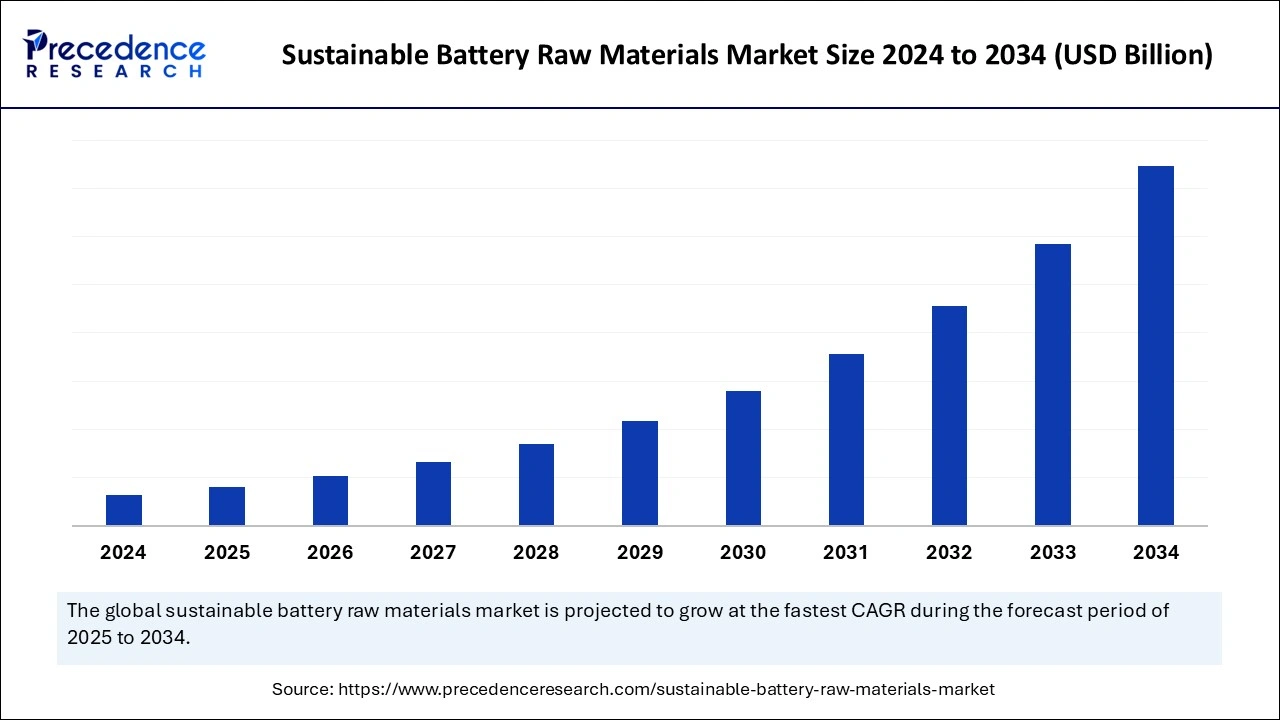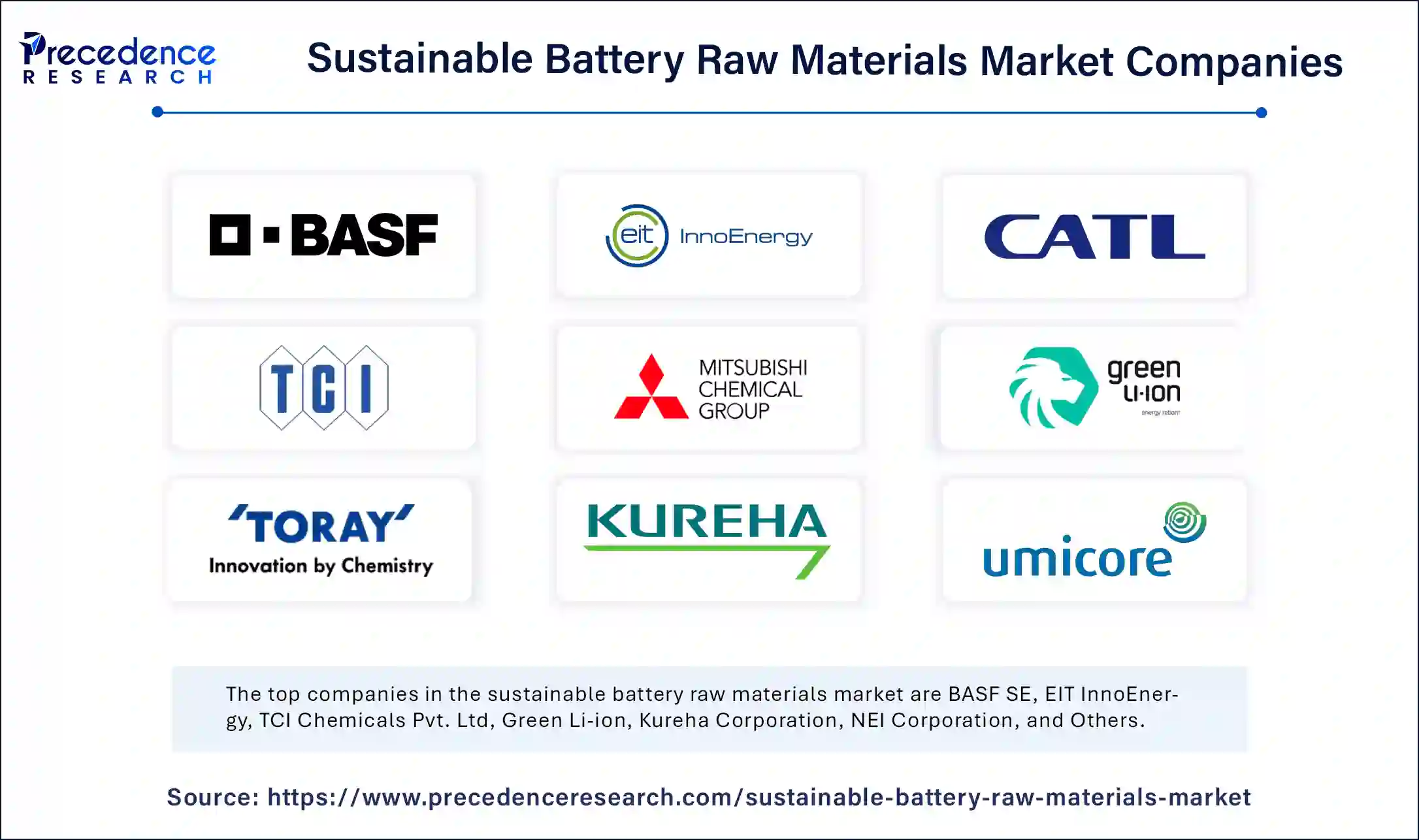Sustainable Battery Raw Materials Market Size and Forecast 2025 to 2034
The increased demand for energy-efficient batteries in electric vehicles is driving the growth of the sustainable battery raw materials market. Rising adoption of renewable energy and energy storage systems are fuelling the market growth. Additionally, advancements in battery technologies are emerging in the market.

Sustainable Battery Raw Materials Market Key Takeaways
- Asia Pacific dominated the global sustainable battery raw materials market in 2024.
- North America is anticipated to witness significant growth in the forecast period.
Artificial Intelligence (AI) Integration and its Impact on the Sustainable Energy Market
Artificial Intelligence is becoming a significant transformer for the adoption and production of sustainable batteries. Also, the leverage of advanced technology like AI is becoming more helpful for the availability and accessibility of sustainable raw materials for the production of high-density and energy-efficient batteries. The rapidly growing demand for innovative and sustainable batteries in automotive, electric vehicles, and consumer electronics has drawn ways for AI entry into the sustainable battery raw materials market.
The increased hopes of AI for accelerating sustainable battery development is an interesting future outlook and will have a spectacular influence on the sustainable battery raw material market. The ability of AI and Machine Learning to improve material recovery rates, improve chances of recyclability, and reduce waste is likely to leave marvelous footprints on the sector.
Market Overview
Raw materials, including lithium, cobalt, nickel, manganese, and graphite, are widely used in the production of batteries. The rising urbanization, industrialization, and population are driving the need for renewable energy sources and energy-efficient solutions, including sustainable batteries. The growing adoption of advanced technologies like three-dimensional battery production is helping with the utilization of sustainable and natural raw materials to improve batteries' eco-friendliness.
Battery electric vehicles (EVs) are playing a major role in this sustainable battery raw materials market. The increased adoption of electric vehicles due to technology advancements and government and regulatory bodies' support and encouragement for the reduction of carbon emissions has enhanced the need for sustainable batteries with high density and energy efficiency. Additionally, increased adoption of consumer electronics and demand for high-performance batteries. Several government policies and funds for the support of raw material availability, cost-effectiveness, and supply chain management are advancing production capabilities and leveraging the profiles of key companies.
- In January 2024, EIT InnoEnergy, a major European private equity and venture capital firm, announced the launching of the EBA Strategic Battery Materials Fund (EBA Materials Fund), which is dedicated to developing a resilient and diverse battery raw material supply chain for Europe.
The EBA Materials Fund is projected to dedicate at least 70% of investments to projected increases in EU domestic production from mining, processing, refining, and recycling in the EU and neighboring countries. The remaining 30% investment will help to increase raw material supply from EU Raw Material Partnership countries, such as Canada, Namibia, and Argentina.
Sustainable Battery Raw Materials Market Growth Factors
- Regulatory initiatives: The growing regulatory initiatives and promotion of sustainability are driving the adoption of renewable energy sources and high-energy-efficient solutions, making enhancement in the adoption of sustainable battery raw materials.
- Increased adoption of electric vehicles: The adoption of electric vehicles has surged due to rising government support and investments. The increased utilization of electric vehicles increases the need for sustainable battery raw materials, including lithium, nickel, manganese, and cobalt.
- Advanced in battery technology: the advancement in battery technology, like next-generation lithium-ion batteries and sodium-state batteries, is emerging in the market.
- Advancements in extraction and mining technologies: The development of cutting-edge, sustainable, and cost-effective mining and extraction technologies, including direct lithium extraction technology, is shaping the market growth.
- Increased adoption of consumer electronics: the growing population has led to the vast adoption of consumer electronics such as smartphones, laptops, and tablets, which is driving the need for sustainable batteries. The increased demand for high-performance and sustainable batteries is contributing to the market expansion.
Market Scope
| Report Coverage | Details |
| Dominating Region | Asia Pacific |
| Fastest Growing Region | North America |
| Base Year | 2024 |
| Forecast Period | 2025 to 2034 |
| Regions Covered | North America, Europe, Asia-Pacific, Latin America, and Middle East & Africa |
Market Dynamics
Drivers
Surge for net-zero transition goals
The growing shift toward sustainability is the key driver of the global sustainable battery raw materials market. The government and environmentally regulated initiatives and investments for research & development of sustainable batteries have increased in order to comply with their commitment to net-zero transition goals. This support has lubricated the increase in the adoption of electric vehicles, which has increased the need for sustainable batteries.
The ongoing focus of automotive manufacturers to reduce scope three emissions is driving the adoption of raw materials for sustainable batteries with lower carbon footprints. Moreover, growing investment in recycling technologies and the adoption of sustainable and cost-effective extraction and mining technologies are shaping the market's success.
Restraint
High cost
The raw materials, such as lithium, cobalt, nickel, and graphite, are expensive, making it challenging for their adoption in the production processes of the sustainable battery raw materials market. The high cost of raw materials increased the overall cost of the batteries. Additionally, the limited development of recyclable batteries is challenging the production industries. Additionally, the costly process of mining and extracting raw materials, including lithium, cobalt, and nickel, can hamper the market growth.
However, the increased demand for lithium-ion batteries in electric vehicles has led to the adoption of cutting-edge technologies called direct lithium extraction technologies. The adoption of innovative technologies and the development of alternative raw materials are expected to overcome such market restraints.
- In December 2024, in collaboration with an international research team, researchers at the Canepa Research Laboratory at the University of Houston developed a sodium vanadium phosphate (NaxV2(PO4)3), a pioneering material to expand the energy density of sodium batteries.
Opportunity
Development of sustainable batteries in EVs
The adoption of electric vehicles has increased due to the government's investment in manufacturing industries and the encouragement of innovations and developments. This innovation has been leveraged due to the government's determination to reduce carbon emissions around the globe. With such support, the demand for sustainable batteries has witnessed growth in the automotive industry. Manufacturers are investing in the development of critical, eco-friendly, and cost-effective raw material-based batteries.
Ongoing innovations for the development of sustainable battery raw materials market applications for electric vehicles with more power, a longer lifespan, and high energy density are emerging in the market worldwide. Furthermore, the current focus of manufacturing companies on the production of recyclable batteries to reduce waste and enhance profit margin is projected to open new doors for the development of innovative and sustainable batteries for electric vehicles in the upcoming period.
- In July 2024, the Republic of Serbia collaborated with the EU under the agreement of a Memorandum of Understanding (MoU) for the launching of sustainable raw materials, battery value chains, and electric vehicles.
- In November 2024, Chery established the world's first GWh-level solid-state battery production line in Wuhu, Anhui Province, with higher energy density to provide a greater range for electric vehicles (EVs).
Regional Insights
High Battery Production Capabilities Make Asia Pacific a Market-Dominant
Asia Pacific is dominating the global sustainable battery raw materials market due to a broad regional base for battery production. The rapidly expanding automotive and renewable energy sectors are making the Asia Pacific a leader in the global market. Easy availability and production of battery raw materials in countries like Belgium, China, India, and Japan are providing more access to affordable batteries. The government initiatives and encouragement for the adoption of electric vehicles with the goal of reducing carbon and greenhouse gas emissions in Asia have surged.
China is leading the Asian market due to the country's vast automotive industries and the adoption of cutting-edge battery technology with higher density and charging capability. The development of advanced technology allows China to adopt sustainable raw materials for the production of eco-friendly batteries with efficient energy storage capabilities and high density. Moreover, the supply concentration of raw materials, including refined nickel, cobalt, and lithium, is making China the leader in the Asian market.
- In November 2024, Honda announced an expansion for its demonstration production line for all-solid-state batteries in Sakura City, Tochigi Prefecture, Japan; the line was scheduled to start test production in January 2025.
Well-Established R&D Sector to Boost the North American Market
North America is anticipated to witness significant growth in the forecast period. This growth is attributed to the presence of well-established and advanced research and development sectors in the region. Key sustainable battery raw materials market companies and raw material production industries in the region fuel the market expansion. Moreover, government investment and support for local battery production are shaping the region's market.
The United States is leading the regional market due to rising government and regulatory initiatives and policies for the adoption of sustainable batteries. These measurements support countries in the development of critical raw materials for the production of sustainable batteries. Government enhancements to encourage the production of sustainable batteries by promoting tax credits, supply chain management, and investments in stakeholders to develop novel, innovative plans for the production of raw materials are driving the North American market toward success.
- In April 2024, Green Li-ion, a lithium-ion battery recycling technology company, announced the launching of its first commercial-scale plant to produce recycled lithium-ion battery materials in North America.
Sustainable Battery Raw Materials Market Companies

- BASF SE
- EIT InnoEnergy
- Contemporary Amperex Technology Co., Limited (CATL)
- TCI Chemicals Pvt. Ltd
- Mitsubishi Chemical Holdings
- Green Li-ion
- TORAY INDUSTRIES INC.
- Kureha Corporation
- Umicore Cobalt & Specialty Materials
- NEI Corporation
- Honda
- Hitachi Chemical Co. Ltd
- Asahi Kasei
Latest Announcements by Industry Leaders
- In July 2024, Maros Sefcovic, Executive Vice-President for the European Green Deal, Interinstitutional Relations, and Foresight, announced that: “partnership between the EU and Serbia on sustainable raw materials will bring battery value chains and electric vehicles forward to the green transition.”
- In December 2024, Pieremanuele Canepa, Robert Welch assistant professor of electrical and computer engineering at UH and lead researcher of the Canepa Lab, announced that: “the latest innovative sodium-ion batteries are affordable and easier to produce, which will help to reduce dependency on lithium and make the battery technology more accessible worldwide.”
Recent Developments
- In November 2024, Contemporary Amperex Technology Co., Limited (CATL) partnered with the Hungarian government to build battery recycling operations in Europe. As per this plan, the company will provide a 100 GWh battery plant in Debrecen, Hungary, which is scheduled to open in 2025.
- In December 2024, Altilium, a UK-based clean technology group, announced the establishment of processing of lithium-ion battery waste at its new ACT2 recycling facility in Plymouth. This launch will help to add a significant step in the UK's progression towards a circular economy for critical battery materials.
Segments Covered in the Report
By Geography
- North America
- Asia Pacific
- Europe
- Latin America
- Middle East and Africa
For inquiries regarding discounts, bulk purchases, or customization requests, please contact us at sales@precedenceresearch.com
Frequently Asked Questions
Ask For Sample
No cookie-cutter, only authentic analysis – take the 1st step to become a Precedence Research client
 sales@precedenceresearch.com
sales@precedenceresearch.com
 +1 804-441-9344
+1 804-441-9344